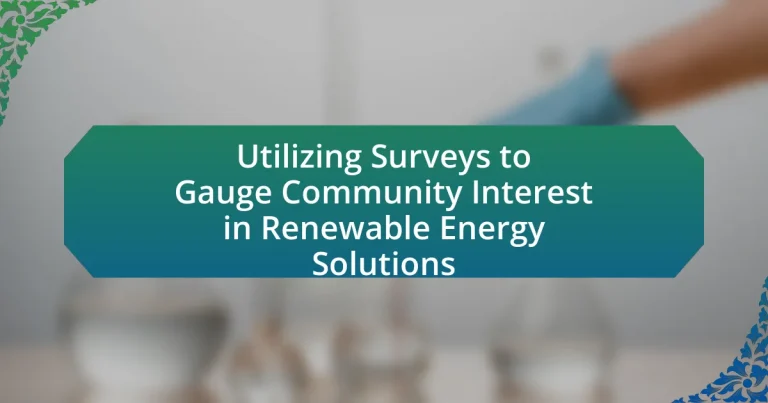Surveys are structured tools essential for collecting data on community opinions, preferences, and behaviors, particularly in the context of renewable energy solutions. This article explores the role of surveys in community engagement, highlighting their effectiveness in gauging interest and shaping policies. Key components of successful surveys include clear objectives, targeted demographics, and effective question design, while challenges such as low response rates and bias are also addressed. The article emphasizes the importance of community support for the successful implementation of renewable energy projects and outlines best practices for utilizing surveys to inform decision-making and enhance public participation.

What are Surveys and Their Role in Community Engagement?
Surveys are structured tools used to collect data from individuals, primarily to understand their opinions, preferences, and behaviors. In the context of community engagement, surveys play a crucial role by enabling organizations to gather insights directly from community members, facilitating informed decision-making and fostering participation in initiatives, such as renewable energy solutions. For instance, a study by the National Renewable Energy Laboratory found that community surveys significantly enhance public involvement in energy projects, leading to higher acceptance rates and more tailored solutions that reflect community needs.
How do surveys function as tools for gauging community interest?
Surveys function as tools for gauging community interest by systematically collecting data on residents’ opinions, preferences, and awareness regarding specific topics, such as renewable energy solutions. They enable researchers and policymakers to quantify community sentiment and identify trends, allowing for informed decision-making. For instance, a survey conducted by the National Renewable Energy Laboratory in 2021 revealed that 75% of respondents supported increased investment in solar energy, demonstrating a clear community interest in this renewable resource. This data-driven approach ensures that initiatives align with public priorities and fosters community engagement in the development of sustainable energy solutions.
What types of surveys are most effective for community engagement?
The most effective types of surveys for community engagement include online surveys, focus groups, and community forums. Online surveys allow for broad participation and can reach a diverse audience quickly, making them ideal for gauging community interest in renewable energy solutions. Focus groups provide in-depth qualitative insights by facilitating discussions among selected community members, which can reveal nuanced opinions and preferences. Community forums encourage open dialogue and collective brainstorming, fostering a sense of ownership and collaboration among participants. Research indicates that combining these methods can enhance engagement, as seen in studies where mixed-method approaches yielded higher response rates and richer data (e.g., the “Community Engagement in Renewable Energy Projects” report by the National Renewable Energy Laboratory).
How can survey design influence community responses?
Survey design significantly influences community responses by shaping how questions are perceived and answered. For instance, the wording of questions can lead to different interpretations, affecting the reliability of the data collected. Research indicates that leading questions can bias responses, while neutral wording tends to yield more accurate reflections of community sentiments. A study published in the Journal of Survey Statistics and Methodology found that surveys with clear, concise questions resulted in a 20% increase in response accuracy compared to those with ambiguous phrasing. Additionally, the format of the survey, whether online or paper-based, can impact participation rates and the demographic diversity of respondents, further influencing the overall results.
Why is community interest important for renewable energy solutions?
Community interest is crucial for renewable energy solutions because it drives local support, ensuring successful implementation and sustainability of projects. When communities are engaged and invested in renewable energy initiatives, they are more likely to advocate for and participate in these projects, leading to higher adoption rates. Research indicates that projects with strong community backing experience fewer delays and greater financial backing; for instance, a study by the National Renewable Energy Laboratory found that community-supported solar projects can increase participation by up to 50%. This demonstrates that understanding and incorporating community interest is essential for the effective deployment of renewable energy solutions.
What impact does community support have on renewable energy projects?
Community support significantly enhances the success of renewable energy projects by fostering local engagement and acceptance. When communities actively support these initiatives, they often lead to smoother project implementation, reduced opposition, and increased likelihood of securing necessary permits. Research indicates that projects with strong community backing can experience up to a 50% increase in successful completion rates, as seen in various case studies across the United States. Furthermore, community involvement can lead to better project design that aligns with local needs, ultimately resulting in higher satisfaction and long-term sustainability of renewable energy solutions.
How can understanding community interest shape renewable energy policies?
Understanding community interest can significantly shape renewable energy policies by ensuring that these policies align with the values and needs of the local population. When policymakers utilize surveys to gauge community interest, they can identify specific renewable energy solutions that residents support, such as solar, wind, or biomass. For instance, a study by the National Renewable Energy Laboratory found that communities with high levels of engagement in energy decision-making are more likely to adopt renewable technologies, leading to increased project success rates. This alignment fosters public support, reduces opposition, and enhances the effectiveness of renewable energy initiatives, ultimately resulting in more sustainable and accepted energy policies.

What are the Key Components of Utilizing Surveys for Renewable Energy Solutions?
The key components of utilizing surveys for renewable energy solutions include clear objectives, targeted demographics, effective question design, data analysis, and actionable insights. Clear objectives ensure that the survey addresses specific aspects of community interest in renewable energy, such as preferences for solar or wind energy. Targeted demographics allow for gathering relevant data from specific community segments, enhancing the survey’s relevance. Effective question design, including both closed and open-ended questions, facilitates comprehensive responses that capture nuanced opinions. Data analysis transforms raw survey data into meaningful patterns and trends, while actionable insights guide decision-making for renewable energy initiatives. These components collectively enhance the effectiveness of surveys in gauging community interest and informing renewable energy strategies.
What specific questions should be included in surveys about renewable energy?
Surveys about renewable energy should include questions that assess awareness, preferences, and willingness to adopt renewable technologies. Specific questions may include:
- How familiar are you with different types of renewable energy sources (e.g., solar, wind, hydro)?
- What renewable energy sources do you believe are most beneficial for your community?
- Would you be willing to invest in renewable energy solutions for your home?
- What factors influence your decision to adopt renewable energy (e.g., cost, environmental impact, reliability)?
- How important is government support in your decision to use renewable energy?
- Have you previously used any renewable energy solutions? If so, which ones?
- What barriers do you perceive in adopting renewable energy technologies?
These questions are designed to gather quantitative and qualitative data that can inform policymakers and energy providers about community attitudes and potential market demand for renewable energy solutions.
How can demographic information enhance survey results?
Demographic information enhances survey results by providing insights into the characteristics and preferences of different population segments. This information allows researchers to analyze how various demographic factors, such as age, gender, income, and education level, influence attitudes towards renewable energy solutions. For instance, a study by the Pew Research Center found that younger individuals are more likely to support renewable energy initiatives compared to older demographics, highlighting the importance of tailoring communication strategies to specific age groups. By incorporating demographic data, survey results become more actionable, enabling stakeholders to design targeted interventions that resonate with distinct community interests and needs.
What are the best practices for formulating survey questions?
The best practices for formulating survey questions include using clear and concise language, avoiding leading or biased questions, and ensuring questions are specific and relevant to the topic. Clear language helps respondents understand the questions without ambiguity, while unbiased questions prevent skewed results. Specificity ensures that the questions directly address the subject matter, such as community interest in renewable energy solutions. Research indicates that well-structured survey questions can significantly improve response quality and data reliability, as evidenced by studies showing that clarity and neutrality in questions lead to more accurate insights into public opinion.
How can data from surveys be analyzed to inform renewable energy initiatives?
Data from surveys can be analyzed to inform renewable energy initiatives by identifying community preferences, awareness levels, and potential barriers to adoption. Analyzing survey responses allows stakeholders to quantify public interest in specific renewable technologies, such as solar or wind energy, and assess demographic factors influencing these preferences. For instance, a survey conducted by the National Renewable Energy Laboratory found that 80% of respondents support increased investment in renewable energy, highlighting a strong community backing for such initiatives. Additionally, analyzing open-ended responses can reveal concerns or misconceptions that need to be addressed, enabling targeted educational campaigns. This data-driven approach ensures that renewable energy initiatives align with community needs and enhance public engagement.
What statistical methods are useful for analyzing survey data?
Statistical methods useful for analyzing survey data include descriptive statistics, inferential statistics, regression analysis, and factor analysis. Descriptive statistics summarize the main features of the data, providing insights into the central tendency and variability, which is essential for understanding community interest in renewable energy solutions. Inferential statistics, such as t-tests and chi-square tests, allow researchers to make generalizations about a population based on sample data, helping to assess the significance of findings. Regression analysis identifies relationships between variables, enabling the prediction of community interest based on factors like demographics or prior knowledge of renewable energy. Factor analysis helps in identifying underlying relationships between survey items, which can reveal key themes in community attitudes toward renewable energy. These methods collectively enhance the analysis of survey data, providing a comprehensive understanding of community perspectives.
How can qualitative feedback from surveys be interpreted?
Qualitative feedback from surveys can be interpreted by analyzing themes, sentiments, and patterns within the responses. This involves coding the feedback into categories that reflect common ideas or feelings expressed by respondents, allowing for a deeper understanding of community perspectives on renewable energy solutions. For instance, if multiple respondents mention concerns about cost, this theme can be identified and quantified to inform decision-making. Research indicates that qualitative analysis can reveal insights that quantitative data may overlook, enhancing the overall understanding of community interest and preferences (Creswell, 2013, “Qualitative Inquiry and Research Design”).

What Challenges Might Arise When Utilizing Surveys in This Context?
Challenges that might arise when utilizing surveys to gauge community interest in renewable energy solutions include low response rates, biased sampling, and misinterpretation of questions. Low response rates can lead to unrepresentative data, as seen in studies where only 10-20% of targeted participants complete surveys. Biased sampling occurs when certain demographics are overrepresented, skewing results; for instance, if surveys are distributed primarily online, individuals without internet access may be excluded. Misinterpretation of questions can result in inaccurate responses, as complex terminology may confuse participants, leading to unreliable data. These challenges can significantly affect the validity and reliability of survey findings in this context.
What common pitfalls should be avoided when conducting surveys?
Common pitfalls to avoid when conducting surveys include leading questions, insufficient sample size, and lack of clarity in questions. Leading questions can bias responses, skewing results; for example, asking “How much do you love renewable energy?” presupposes a positive sentiment. Insufficient sample size can lead to unrepresentative results, as a study by the Pew Research Center indicates that larger samples yield more reliable data. Lack of clarity in questions can confuse respondents, resulting in inaccurate answers; research shows that ambiguous questions can lead to a 30% increase in non-responses. Avoiding these pitfalls ensures more accurate and actionable survey results.
How can bias in survey responses be minimized?
Bias in survey responses can be minimized by employing randomized sampling methods and ensuring question neutrality. Randomized sampling reduces selection bias by giving every individual in the target population an equal chance of being selected, which enhances the representativeness of the survey results. Additionally, using neutral wording in survey questions prevents leading respondents toward a particular answer, thereby reducing response bias. Research indicates that surveys with neutral questions yield more accurate reflections of public opinion, as evidenced by a study published in the Journal of Survey Statistics and Methodology, which found that neutral phrasing improved response accuracy by 15%.
What strategies can be employed to increase survey participation?
To increase survey participation, employing strategies such as offering incentives, simplifying the survey design, and targeting specific demographics can be effective. Research indicates that providing incentives, such as gift cards or discounts, can boost response rates by up to 25% (Dillman et al., 2014). Simplifying the survey design by reducing the number of questions and ensuring clarity can enhance user experience, leading to higher completion rates. Additionally, targeting specific demographics through tailored outreach efforts can increase engagement, as surveys that resonate with the audience’s interests yield better participation.
How can survey results be effectively communicated to stakeholders?
Survey results can be effectively communicated to stakeholders by utilizing clear visualizations, concise summaries, and actionable insights. Visualizations such as charts and graphs help stakeholders quickly grasp key findings, while concise summaries distill complex data into understandable points. Actionable insights provide stakeholders with specific recommendations based on the survey results, facilitating informed decision-making. For instance, a study by the American Psychological Association found that visual data representation increases retention and understanding by up to 80%, underscoring the importance of effective communication methods in stakeholder engagement.
What formats are best for presenting survey findings?
The best formats for presenting survey findings include visual formats such as charts, graphs, and infographics, as well as written reports and presentations. Visual formats effectively convey complex data in an easily digestible manner, allowing for quick comprehension of trends and patterns. For instance, bar graphs can illustrate the percentage of respondents favoring renewable energy solutions, while pie charts can show the distribution of opinions on specific initiatives. Written reports provide detailed analysis and context, which can enhance understanding and support decision-making. Presentations allow for interactive engagement, enabling stakeholders to ask questions and discuss findings in real-time. These formats are supported by research indicating that visual data representation improves retention and understanding, making them effective for communicating survey results.
How can storytelling enhance the impact of survey results?
Storytelling can enhance the impact of survey results by transforming raw data into relatable narratives that resonate with audiences. When survey findings are presented through storytelling, they become more engaging and easier to understand, allowing stakeholders to connect emotionally with the information. For instance, a survey revealing community support for renewable energy can be illustrated with personal stories of local residents who have benefited from such initiatives, making the data more compelling. Research indicates that narratives can increase retention of information by up to 65%, demonstrating that storytelling effectively reinforces the significance of survey results and encourages action based on those insights.
What are the best practices for utilizing surveys to gauge community interest in renewable energy solutions?
The best practices for utilizing surveys to gauge community interest in renewable energy solutions include designing clear and concise questions, ensuring a representative sample, and employing multiple distribution methods. Clear questions help respondents understand what is being asked, which increases the quality of the data collected. A representative sample ensures that the survey results reflect the views of the entire community, not just a subset. Utilizing various distribution methods, such as online platforms, community events, and mail, maximizes participation and engagement. According to a study by the National Renewable Energy Laboratory, surveys that incorporate these practices yield more reliable insights into community preferences and attitudes towards renewable energy initiatives.




